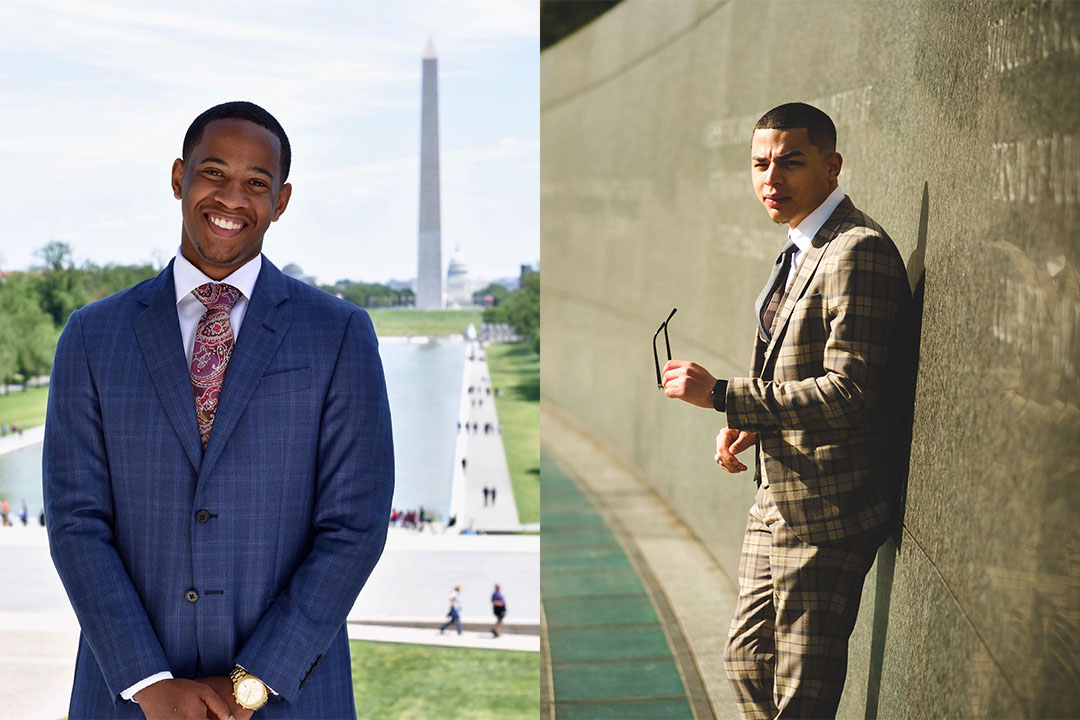In summer 2020, then-senior business administration major Owen Manning, BBA ’21, watched from his home in Atlanta as protests against racial injustice swept through Washington, D.C., and cities across the world. Inspired by the stories of Black people fighting to make their voices heard, Mr. Manning called his friend Naseem Haamid, BA’21, a political science major from the Bronx, N.Y., to share his enthusiasm.
“We felt like we had to do something to mark this moment,” Mr. Manning said.
Luckily, they already had a story to tell.
During the fall 2019 semester, Mr. Manning and Mr. Haamid were students in a class called Black Feminist Theory—Lemons Into Lemonade: Black Women in the US. Taught by Jordan S. West, GW's associate vice provost for diversity, equity and community engagement, the class celebrated the resilience and empowerment of Black women throughout American history.
As a class project, Mr. Manning and Mr. Haamid designed a mural commemorating Leah Brock McCartney, the first Black alumna at GW in 1954 and a pioneering judge in Missouri. Now, the creators are determined to bring that mural to life, taking it from a classroom drawing board to a Foggy Bottom site.
Mr. Manning and Mr. Haamid are leading a cross-university initiative called the Leah Brock McCartney Project. Bringing together the GW family, the D.C. arts community and alumni around the world, the creators have embarked on a mission to erect a mural on campus honoring Ms. McCartney and “uplifting Black history at GW,” Mr. Haamid said.
Owen Manning (left) and Naseem Haamid (right) are transforming a classroom project into a campus mural honoring Leah Brock McCartney, the first Black alumna at GW.
The proposed 26 X 36 feet mural will be created by a local Black female artist. With the support of university leadership and aid from faculty advisers, university archivists and a host of departments from the Office for Diversity, Equity and Community Engagement to Safety and Facilities, the team is aiming to complete the mural by the end of the next academic year.
“Owen and Naseem were compelled through their academic experience to take action,” said Dr. West, who is also a faculty member in the Columbian College Department of Women’s, Gender and Sexuality Studies. “It is through their strength and their persistence that this project will positively impact the GW community, the D.C. community and even society at large while supporting, celebrating and honoring Black women.”
The classmates who also participated in the project include Malaika Hall, BA ’20, Simone Hunter-Hobson, BA ’20, Marie-Helene De-Messou, BA ’20, and Arion Laws, BA ’20.
Mr. Manning and Mr. Haamid knew little about Ms. McCartney before taking Dr. West’s course—a fact that both found troubling. The pair were leaders in the GW student community. Mr. Manning is a former president of the Black Student Union and a Posse Scholar who has sat on numerous university committees and task forces. Mr. Haamid was the president of the undergraduate chapter of the GW Black Law Students Association and a former vice president of the Black Men's Initiative at GW.
But to both, Ms. McCartney’s story was largely unknown. Born in 1911 in Ellisville, Miss., Ms. McCartney spent years as a teacher before even enrolling in GW. She received an L.L.B. degree in 1954, the same year that GW abolished restrictions on minority student admissions. (Previously, Black students could only attend evening classes.) In 1968, she became the first Black woman to earn a law degree from GW, graduating with the highest grade point average in her third-year class despite working full-time during her studies.
During her illustrious legal career, she was the first female municipal judge of record in Missouri, taught law at the University of Tulsa and became the first Black person to serve on the Missouri Public Service Commission.
To the two creators, Ms. McCartney’s story had a familiar ring—the unrecognized legacy of an accomplished Black woman.
“As members of marginalized communities, we know what it's like to be left out,” Mr. Manning said.
Mr. Haamid, who is interested in law, noted how Ms. McCartney’s example has motivated him to pursue his academic goals. “It’s inspiring to know that Judge McCartney paved the way for students like me at GW,” he said. “We truly stand on the shoulders of giants like her.”
After months of intensive research with the help of GW Libraries and university archivists—made more difficult due to pandemic parameters—the creators formally presented their proposal to GW President Thomas LeBlanc in October. Mindful of the importance of collaborating with Black women, they turned to Chanel Compton, an artist with the DC Commission for Arts and Humanities and executive director of the Banneker Douglass Museum in Maryland, to help design and create the mural.
“I am very proud of Owen and Naseem,” Dr. LeBlanc said. “Their extensive research, collaborative approach, and passion for honoring Judge McCartney demonstrate true leadership and a commitment to ensuring GW is a welcoming and inclusive place for all. I hope that our students, faculty, staff and alumni will join me in supporting this incredible effort.”
Mr. Manning and Mr. Haamid are leading all aspects of the project with the active support of Dr. West, from working with the District government to raising the funds for the project cost. Although they are still in the initial fundraising stages, they recently secured a $10,000 pledge from the GW Luther Rice Society. The final campus location of the mural has yet to be announced.
Mr. Manning and Mr. Haamid said they’re committed to sharing Ms. McCartney’s story and will continue to guide the project through its completion. In addition to celebrating the extraordinary life of a historic Black alumna, they hope the mural will resonate with GW students.
“When you walk by this mural on campus,” Mr. Manning said, “whether you’re a Black woman or other races and identities, I hope it makes you feel like this is a place that shares your values—this is a place where you want to be.”



